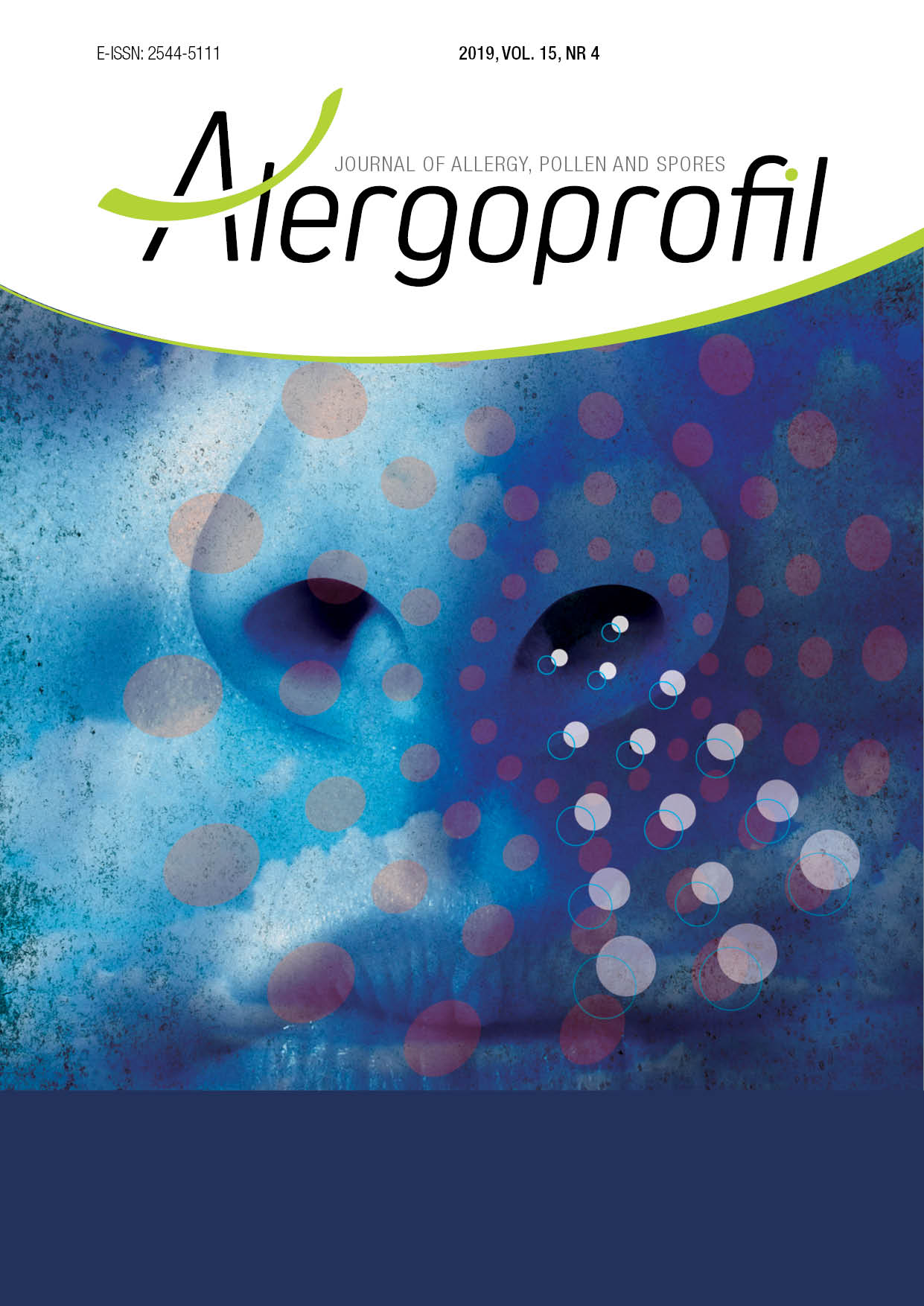Ash pollen season in Poland in 2019
##plugins.themes.bootstrap3.article.main##
Abstrakt
Pollen grains are one of the most important groups of atmospheric biological particles that cause allergic processes. Meteorological factors affect the occurrence of pollen allergen release in the air. In order to shed light on this phenomenon this study compares the ash pollen seasons in Bialystok, Bydgoszcz, Sosnowiec, Piotrkow Trybunalski, Opole, Olsztyn, Szczecin, Warsaw and Lublin in 2019. The investigations were carried out using the volumetric method (Hirst type pollen sampler). Seasonal Pollen Index (SPI) was estimated as the sum of daily average pollen concentrations in the given season. The ash pollination is mainly observed in April. Diagnosis of ash pollen allergy is made difficult due to an overlapping pollination period with Betulaceae and some cross-reactivity with allergens from Betulaceae. It is not clear whether ash pollen is a primary cause of sensitization or whether it is implicated through cross-sensitization to other pollens. In 2019 the pollen season of ash started first in Opole, on the March 9th. At the latest, a pollen season ended in Bialystok, after mid may. The differences of pollen seasons duration were very considerable, from 28 to 50 days. The highest airborne concentration of 190 pollen grains/m3 was noted in Lublin on the April 21st. The maximum values of seasonal pollen count in Polish cities occurred between April 4th and 22nd, most often between April 18th–22nd. The highest ash pollen allergen hazard occurred in 2019 in Lublin, Warsaw, Piotrkow Trybunalski and Bydgoszcz, and was at least three times higher than in other cities. The highest variability in the analysed seasons was found in the peak value and annual total.
Pobrania
##plugins.themes.bootstrap3.article.details##
Copyright: © Medical Education sp. z o.o. This is an Open Access article distributed under the terms of the Attribution-NonCommercial 4.0 International (CC BY-NC 4.0). License (https://creativecommons.org/licenses/by-nc/4.0/), allowing third parties to copy and redistribute the material in any medium or format and to remix, transform, and build upon the material, provided the original work is properly cited and states its license.
Address reprint requests to: Medical Education, Marcin Kuźma (marcin.kuzma@mededu.pl)
Bibliografia
2. APG II system. An update of the angiosperm phylogeny group classification for the orders and families of flowering plants: APG II. Bot J Linn Soc. 2003; 141(4): 135-140.
3. Ralska-Jasiewiczowa M, Latałowa M, Wasylikowa K et al (eds). Late Glacial and Holocene history of vegetation in Poland based on isopollen maps. Polish Academy of Sciences, Cracow 2004.
4. Silva Palacios I, Tormo Molina R, Munoz Rodriguez AF. The importance of interactions between meteorological conditions when interpreting their effect on the dispersal for pollen from homogeneously distributed sources. Aerobiologia. 2007; 23: 17-26.
5. Jianan X, Zhiyun O, Hua Z et al. Allergenic pollen plants and their influential factors in urban areas. Acta Ecologica Sinica. 2007; 27(9): 3820-3827.
6. Mandrioli P, Comtois P, Dominguez E et al. Sampling: Principles and Techniques. In: Mandrioli P, Comtois P, Levizzani V (eds). Methods in Aerobiology. Pitagora Editrice Bologna. Bologna 1998, 47-112.
7. Emberlin J, Savage M, Woodman R. Annual variations in the concentrations of Betula pollen in the London area 1961–1990. Grana. 1993; 32: 359-363. https://doi.org/10.1080/00173139309428965.
8. Lipiec A, Weryszko-Chmielewska E, Piotrowska K et al. Analiza stężenia pyłku jesionu w wybranych miastach Polski w 2007 r. Alergoprofil. 2007; 3(3): 50-54.
9. Rapiejko P. Alergeny pyłku jesionu. Alergoprofil. 2008; 4(1): 46-48.
10. Steinman H. Tree pollens. Allergy – Which allergens? Allergy Resources International. Sweden 2008: 188.
11. Hemmer W, Focke M, Wantke F et al. Ash (Fraxinus excelsior) – pollen allergy in central Europe: Specific role of pol-len panallergens and the major allergen of ash pollen, Fra e 1. Allergy. 2000; 55: 923-930.
12. Szczygielski K, Puc M, Stacewicz A et al. Ash pollen count in the air of selected Polish cities in 2017. Alergoprofil. 2017; 13(2): 85-90..
13. Puc M, Rapiejko P, Myszkowska D et al. Pyłek jesionu w powietrzu wybranych miast Polski w roku 2008. Alergoprofil. 2008; 4(3): 35-39.
14. Jochner-Oette S, Stitz T, Jetschni J et al. The Influence of Individual-Specific Plant Parameters and Species Composition on the Allergenic Potential of Urban Green Spaces. Forests. 2018; 9: 284. https://doi.org/10.3390/f9060284.
15. Ogren T. The Allergy-Fighting Garden. Ten Speed Press. Berkeley, CA 2015: 205.

